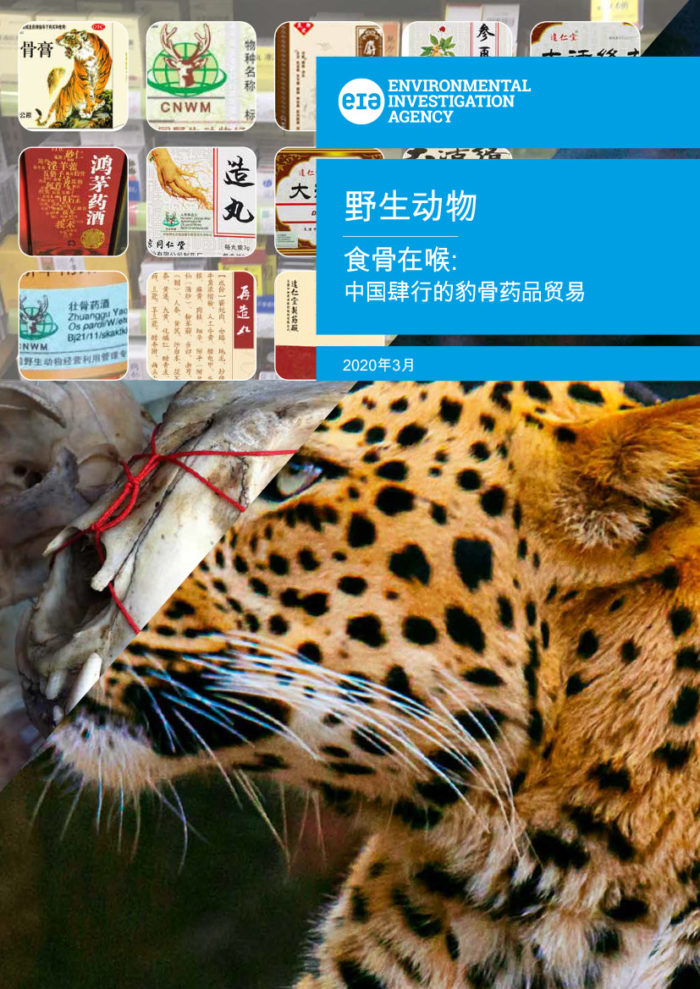Special briefing: As China reviews wildlife law, we call for an end to its leopard bone trade
Scroll down for Chinese version
中文版在本页底部
In a new report from the Environmental Investigation Agency (EIA), 24 Chinese pharmaceutical companies are exposed as listing leopard bones as an ingredient in their traditional medicines.
 Use of leopard bone in traditional medicine is still legal in China, despite there being fewer than 450 wild leopards left in the country. International trade has been banned since 1975 – raising serious questions as to where the leopard bone in trade came from.
Use of leopard bone in traditional medicine is still legal in China, despite there being fewer than 450 wild leopards left in the country. International trade has been banned since 1975 – raising serious questions as to where the leopard bone in trade came from.
Illegal killing for their body parts is driving Asia’s leopards to extinction. They have already disappeared from Laos, Vietnam and Singapore and are on the brink in several other countries. Demand for their bones, primarily from Chinese consumers, is one of the drivers of the trade. Leopard bone is used in similar ways to tiger bone, steeped in rice wine to produce health tonics and used in other traditional medicines.
Purchase of leopard bone by manufacturers appears to be continuing, despite a regulation that companies could only use stock they held prior to March 2006. The quantities and origins of this leopard bone has never been publicly declared and the full scale of China’s domestic leopard bone trade and the total number of companies involved remains largely unknown because of a lack of Government transparency.
EIA trawled through scores of traditional Chinese medicine websites and found that labelling or packaging of 62 different pills, plasters and tonics recorded the use of leopard bone.
“This is just the tip of the iceberg,” said Aron White, EIA Wildlife Campaigner and China Specialist. “It is not just leopards. At least 46 Government permits to trade in or use parts of species under the highest levels of protection have been issued to traditional medicine companies since September 2017.”
Many academics, NGOs and members of the public in China have been calling for greater restrictions on wildlife trade, including for bans to be extended to cover use in traditional medicine. Chinese lawmakers now have a timely opportunity to listen to these advocates and end the use of leopards and other threatened species in traditional Chinese medicine. China’s National People’s Congress – the country’s highest law-making body – is due to revise the Wildlife Protection Law, possibly as soon as April.
“We are urging the Government to amend national legislation to end the use of leopard and other threatened species in traditional Chinese medicine (TCM),” said White. “The world is facing a biodiversity crisis and this is a critical opportunity for China’s leadership to act and address the role of consumer demand that is contributing to it.”
EIA recognises that most TCM does not contain wildlife parts and a nuanced approach is required. By ending the use of threatened wildlife, the Chinese Government and industry would conversely prevent the actions of a minority negatively impacting on the image of the whole TCM industry.
“Amending the law to end the use of threatened wildlife in medicine would be a win-win for biodiversity and the image of traditional Chinese medicine,” says White. “China has an opportunity to become a genuine leader in conservation, and we hope other countries would follow its example.”
在《野生动物保护法》修订期的特别发表:呼吁采取行动终止中国的豹骨贸易
在一份新报告中,环境调查署 (EIA)曝光了有迹象在制造并销售含有豹骨成分的药品的24家中医药制造商
 尽管中国全国野生豹的数量不到450只,但是在中国药用豹骨仍然是合法的。自1975年以来,豹制品的国际贸易一直是非法的——因此让人怀疑中国国内贸易中豹骨的来源。
尽管中国全国野生豹的数量不到450只,但是在中国药用豹骨仍然是合法的。自1975年以来,豹制品的国际贸易一直是非法的——因此让人怀疑中国国内贸易中豹骨的来源。
以贩卖豹的身体部分为目的的非法盗猎正在让野生豹数量在亚洲各地大幅下降。豹在老挝、越南和新加坡已经灭绝,在柬埔寨和中国濒近灭绝。推动此贸易的原素之一是对豹骨的需求,主要来自中国消费者。豹骨的消费与虎骨的消费方法相似,泡在酒里以制造所谓的药酒或者用于生产中成药。
尽管有法规规定中医药制造商只能使用在2006年3月之前已经持有的库存豹骨,但制造商似乎持续收购豹骨。2006年库存的豹骨的数量和来源从未公开宣布过。因为中国有关部门对豹骨贸易缺乏透明度,我们对中国国内的豹骨贸易规模以及从事豹骨贸易公司的数量仍然无从所知。
EIA翻阅了数十个中医药网站,发现了有62种药丸,膏药和药酒,从制造商官网、包装或者说明书上有意象其含有豹骨。
“这只是冰山一角。” EIA野生动物项目的Aron White说。 “不仅仅是豹子。自2017年9月以来,有关部门向中医药公司颁发了至少46张允许收购、出售、利用国家一级重点保护野生动物的许可证。”
在最近几个月里,中国许多学者、非政府组织和公众在呼吁对野生动物贸易实行更严格的限制,包括呼吁国家扩大禁止野生动物用于药用。全国人民代表大会即将修订《野生动物保护法》——中国决策者在此有机会听取这些倡导者的意见,终止包括豹在内受威胁野生动物的药用和贸易。
“我们敦促政府修改国家立法以终止豹等受威胁野生动物的药用。”White说。 “世界正面临着生物多样性危机,中国领导人现在有机会采取行动以压抑对野生动物制品的的需求,从而帮助解决这个危机。”
环境调查署认识到大多数中医药不包含任何野生动物成分,而且对于管制涉及野生动物的药不能以偏概全。通过终止使用受威胁野生动物成分的药用做法,中国政府以及中医药企业将防止少数人的行为对整个中医药的形象产生负面影响。
“中国修改法律以终止受威胁野生动物的药用将对生物多样性和中医药的形象产生双赢的结果。”White说。 “中国有机会成为真正的环境保护领导者,我们希望其他国家也会效仿。”



